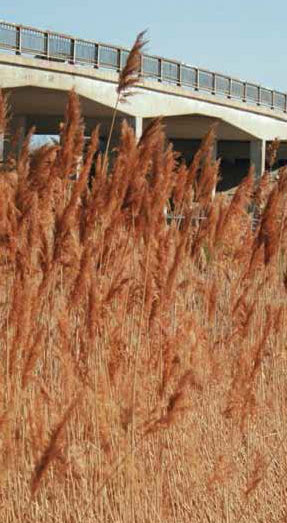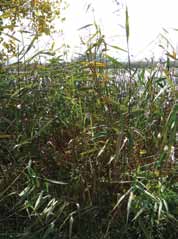Phragmites fact sheet
What you need to know about phragmites. Includes habitat, identifying features and what you can do to reduce its impact.
Invasive species fact sheet - Invasive Phragmites (Phragmites australis subsp. australis)
Invasive Phragmites (European Common Reed) is an invasive plant causing damage to Ontario’s biodiversity, wetlands and beaches. Invasive Phragmites is a perennial grass that has been damaging ecosystems in Ontario for decades. It is not clear how it was transported to North America from its native home in Eurasia.
Invasive Phragmites is an aggressive plant that spreads quickly and out-competes native species for water and nutrients. It releases toxins from its roots into the soil to hinder the growth of and kill surrounding plants. While it prefers areas of standing water, its roots can grow to extreme lengths, allowing it to survive in relatively dry areas.
Impacts of Invasive Phragmites
Invasive Phragmites:
- crowds out native vegetation, thus resulting in decreased plant biodiversity;
- generally provides poor habitat and food supplies for wildlife, including several Species at Risk;
- grows very quickly thereby causing lower water levels as water is transpired faster than it would be with native vegetation;
- increases fire hazards as stands are composed of a high percentage of dead stalks; and
- can affect agriculture, cause road safety hazard and impact recreational activities such as swimming, boating and angling.





Identifying invasive Phragmites
One factor making the identification of invasive Phragmites difficult is the existence of a closely related native subspecies. Generally, native Phragmites does not grow as tall as the invasive plant and does not out-compete other native species. A number of characteristics of the plant can be useful in distinguishing between the native variety and invasive Phragmites. The following information can help in identifying invasive Phragmites.
Invasive Phragmites:
- grows in stands that can be extremely dense with as many as 200 stems per square metre;
- can grow so densely that it crowds out other species;
- can reach heights of up to 5 metres (15 feet), and
- has stems that are tan or beige in colour with blue-green leaves and large, dense seedheads.
Native Phragmites:
- grows in stands that are usually not as dense as the invasive plant;
- well-established stands are frequently mixed with other plants; and
- usually has more reddish-brown stems, yellow-green leaves and smaller, sparser seedheads.
What can I do?
- Learn how to identify invasive Phragmites and how to avoid accidentally spreading it through its root fragments and seeds. This is especially important if you are planning to do work in an area which contains invasive Phragmites,
- Do not plant invasive Phragmites. Native Phragmites have the same appearance and do not pose an ecological risk.
- Gardeners should use only native or non-invasive plants and are encouraged to ask garden centres for plants that are not invasive.
- Stay on designated trails. Leaving trails or entering areas containing invasive Phragmites can encourage the spread of this plant. When leaving an area containing invasive Phragmites, brush off clothing and clean equipment onsite to avoid the transfer of seeds to new areas. Remove all visible portions of plants and dispose them in the garbage.
- Do not compost invasive Phragmites. Both seeds and rhizomes (horizontal plant stems growing underground) can survive and grow in compost.
Other resources
Ontario Invasive Plant Council
Ontario’s Invading Species Awareness Program
Stop the spread of invasive species
For more information
Contact the Invading Species Hotline at